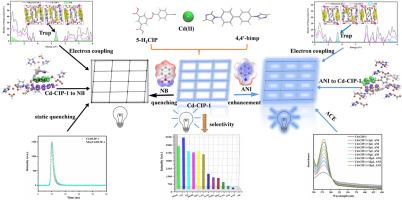当前位置:
X-MOL 学术
›
Anal. Chim. Acta
›
论文详情
Our official English website, www.x-mol.net, welcomes your feedback! (Note: you will need to create a separate account there.)
Quenching and enhancement mechanisms of a novel Cd-based coordination polymer as a multiresponsive fluorescent sensor for nitrobenzene and aniline
Analytica Chimica Acta ( IF 5.7 ) Pub Date : 2024-06-12 , DOI: 10.1016/j.aca.2024.342865 Xiaoming Song , Qingxia Zhao , Mingxuan Dang , Xiufang Hou , Shuai Liu , Zhihu Ma , Yixia Ren
Analytica Chimica Acta ( IF 5.7 ) Pub Date : 2024-06-12 , DOI: 10.1016/j.aca.2024.342865 Xiaoming Song , Qingxia Zhao , Mingxuan Dang , Xiufang Hou , Shuai Liu , Zhihu Ma , Yixia Ren

|
Nitroaromatic compounds are inherently hazardous and explosive, so convenient and rapid detection strategies are needed for the sake of human health and the environment. There is an urgent demand for chemical sensing materials that offer high sensitivity, operational simplicity, and recognizability to effectively monitor nitroaromatic residues in industrial wastewater. Despite its importance, the mechanisms underlying fluorescence quenching or enhancement in fluorescent sensing materials have not been extensively researched. The design and synthesis of multiresponsive fluorescent sensing materials have been a great challenge until now. In this study, a one-dimensional Cd-based fluorescent porous coordination polymer (Cd–CIP-1) was synthesized using 5-(4-cyanobenzyl)isophthalic acid (5-HCIP) and 4,4′-bis(1-imidazolyl)biphenyl (4,4′-bimp) and used for the selective detection of nitrobenzene in aqueous solution by fluorescence quenching, with a limit of detection of 1.38 × 10 mol L. The presence of aniline in the Cd–CIP-1 solution leads to the enhancement of fluorescence property. Density functional theory and time-dependent density functional theory calculations were carried out to elucidate the mechanisms of the fluorescence changes. This study revealed that the specific pore size of Cd–CIP-1 facilitates analyte screening and enhances host-guest electron coupling. Furthermore, π–π interactions and hydrogen bond between Cd–CIP-1 and the analytes result in intermolecular orbital overlap and thereby boosting electron transfer efficiency. The different electron flow directions in NB@Cd–CIP-1 and ANI@Cd–CIP-1 lead to fluorescence quenching and enhancement. The multiresponsive coordination polymer (Cd–CIP-1) can selectively detect nitrobenzene and recognize aniline in aqueous solutions. The mechanism of fluorescence quenching and enhancement has been thoroughly elucidated through a combination of density functional theory and experimental approaches. This study presents a promising strategy for the practical implementation of a multiresponsive fluorescent chemical sensor.
中文翻译:

新型镉基配位聚合物作为硝基苯和苯胺多响应荧光传感器的猝灭和增强机制
硝基芳香族化合物本身具有危险性和爆炸性,因此为了人类健康和环境,需要方便、快速的检测策略。人们迫切需要具有高灵敏度、操作简单性和可识别性的化学传感材料,以有效监测工业废水中的硝基芳香族残留物。尽管其重要性,但荧光传感材料中荧光猝灭或增强的机制尚未得到广泛研究。迄今为止,多响应荧光传感材料的设计和合成一直是一个巨大的挑战。在这项研究中,使用5-(4-氰基苄基)间苯二甲酸(5-HCIP)和4,4′-双(1-咪唑基)合成了一种一维Cd基荧光多孔配位聚合物(Cd-CIP-1)。 )联苯 (4,4′-bimp),用于通过荧光猝灭选择性检测水溶液中的硝基苯,检测限为 1.38 × 10 mol L。Cd–CIP-1 溶液中苯胺的存在导致以增强荧光性能。进行密度泛函理论和随时间变化的密度泛函理论计算以阐明荧光变化的机制。这项研究表明,Cd-CIP-1 的特定孔径有利于分析物筛选并增强主客体电子耦合。此外,Cd-CIP-1 与分析物之间的 π-π 相互作用和氢键导致分子间轨道重叠,从而提高电子转移效率。 NB@Cd–CIP-1 和 ANI@Cd–CIP-1 中不同的电子流方向导致荧光猝灭和增强。 多响应配位聚合物(Cd-CIP-1)可以选择性地检测水溶液中的硝基苯并识别苯胺。通过密度泛函理论和实验方法的结合,荧光猝灭和增强的机制已被彻底阐明。这项研究为多响应荧光化学传感器的实际实施提供了一种有前景的策略。
更新日期:2024-06-12
中文翻译:

新型镉基配位聚合物作为硝基苯和苯胺多响应荧光传感器的猝灭和增强机制
硝基芳香族化合物本身具有危险性和爆炸性,因此为了人类健康和环境,需要方便、快速的检测策略。人们迫切需要具有高灵敏度、操作简单性和可识别性的化学传感材料,以有效监测工业废水中的硝基芳香族残留物。尽管其重要性,但荧光传感材料中荧光猝灭或增强的机制尚未得到广泛研究。迄今为止,多响应荧光传感材料的设计和合成一直是一个巨大的挑战。在这项研究中,使用5-(4-氰基苄基)间苯二甲酸(5-HCIP)和4,4′-双(1-咪唑基)合成了一种一维Cd基荧光多孔配位聚合物(Cd-CIP-1)。 )联苯 (4,4′-bimp),用于通过荧光猝灭选择性检测水溶液中的硝基苯,检测限为 1.38 × 10 mol L。Cd–CIP-1 溶液中苯胺的存在导致以增强荧光性能。进行密度泛函理论和随时间变化的密度泛函理论计算以阐明荧光变化的机制。这项研究表明,Cd-CIP-1 的特定孔径有利于分析物筛选并增强主客体电子耦合。此外,Cd-CIP-1 与分析物之间的 π-π 相互作用和氢键导致分子间轨道重叠,从而提高电子转移效率。 NB@Cd–CIP-1 和 ANI@Cd–CIP-1 中不同的电子流方向导致荧光猝灭和增强。 多响应配位聚合物(Cd-CIP-1)可以选择性地检测水溶液中的硝基苯并识别苯胺。通过密度泛函理论和实验方法的结合,荧光猝灭和增强的机制已被彻底阐明。这项研究为多响应荧光化学传感器的实际实施提供了一种有前景的策略。











































 京公网安备 11010802027423号
京公网安备 11010802027423号